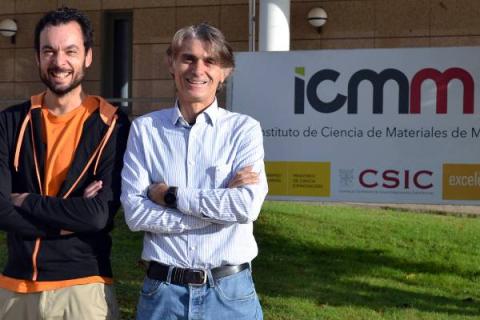Ricardo García and Andrés Castellanos-Gomez got the Miguel Catalán Award for their research in the area of Science

Ricardo García and Andrés Castellanos-Gomez, scientists from the Institute of Materials Science of Madrid (ICMM), CSIC, have been awarded the Miguel Catalán prize from the Community of Madrid for their research in the area of Science.
These research prizes are divided into two categories: the scientific career prize, which went to Ricardo García, from the 'Advanced force microscopy and nanolithography (ForceTool)' group, seeks to recognize the scientific activity, "as well as scientific values and developed humanistic studies", explains the call from the Community of Madrid. The second category is for researchers under 40 years of age and has fallen to Andrés Castellanos-Gomez, from the 'Fundición 2D' group. This award aims to "stimulate, recognize and reward the quality and excellence of the scientific and research work developed at the beginning of his research career"This resolution has achieved both objectives, the first time that falls on two researchers from the same study center. "I am very excited, in the life of an adult it is rare to be told that you are doing something well," says Castellanos-Gomez, who has also received the National Research Award this year. At his side is García, a researcher for almost 40 years. "I am very honored and satisfied," he says. With a research career award, it's impossible not to look back... but even more challenging to review a single scientific milestone of all the discoveries made since 1985. "It's very difficult to point to a single result," says García, who explains that he always tries to "do his best" in everything he does. "What makes me stand out the most is the discovery of bimodal technology in force microscopy," he acknowledges at the end, noting that this discovery has had applications in the most basic science and in the industrial world.
Although this award recognizes the work done, both researchers cannot stop talking about everything that remains to be done, since the challenges are many and common: obtaining projects and stable financing. "The prize motivates you, but the challenge does not disappear, there is nothing guaranteed [in the scientific career]," says García while Castellanos-Gomez jokes: "Does it never end?". "It is an encouragement to continue giving our best, trying to get the results from the laboratory to reach the real world," continues García, who regrets how difficult it is for the latter to happen: "Getting to hospitals, to the industry... nobody has the magic recipe. In my case I will try to choose carefully the problems in which I invest my time".
Castellanos-Gómez, with a cutting-edge and young research group, points out the consolidation of his laboratory as an immediate challenge: "You have to keep rowing to make it stable; create a school," he comments. He, as a scientist, is focusing his career on electronics on paper, thinking about the creation of biodegradable materials: "We have a serious problem with electronic waste, it is a challenge that must be faced," he adds.
The two, visibly grateful for the recognition and happy to meet each other, comment that the important thing, despite everything, is to continue having fun while working: "we had a great time, I think it's essential to have fun with the science that one does", he mentions Castellanos-Gomez. García, for his part, ends with a reflection: "Sometimes one perceives that as you have a broader career, they evaluate you negatively when it comes to granting you projects, and that should be judged without looking at age or gender." Castellanos-Gomez, sitting next to him, nods. Science has many challenges to face, and both 'juniors' and 'seniors' have a lot to contribute along the way.
-- Ángela R. Bonachera (text) and Carlos Arroyo (photo) - ICMM-CSIC Communication--
Instituto de Ciencia de Materiales de Madrid (ICMM)
Sor Juana Ines de la Cruz, 3
Cantoblanco, 28049
Madrid, España
Telephone: (+34) 91 334 90 00
Email: @email
Communication Office: @email

Acknowledge the Severo Ochoa Centres of Excellence program through Grant CEX2024-001445-S/ financiado por MICIU/AEI / 10.13039/501100011033

Contacto | Accesibilidad | Aviso legal | Política de Cookies | Protección de datos